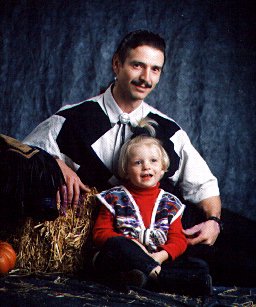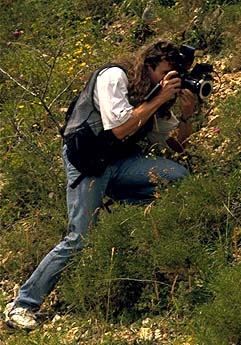| [About me] | [About butterflies] | [Tips] | [This WebSite] |
![]() Some information about me and about photographing butterflies:
Some information about me and about photographing butterflies:
 This is me with my little daughter Romana. |
I was born on 18th October 1961 and
I live and work in Erlangen as a software-developer at Siemens. I have been
photographing butterflies for about 15 or 17 years. The first pictures I took were made
with a telephoto lens on negative-films. Later on I used a close-up lens and also tried
extension-tubes, but I have never been really satisfied with the results. I decided to buy
a special macro-lens with a ring-flash. Simultaneously I changed to slides (for some time
only Fuji Velvia, ISO 50) because it seemed to be cheaper, especially when you account for
rejected photos. When using negative-films I was often
disappointed with the way the lab printed the photos. Moreover, slides have a better
color-depth and contrast dimension. However because of the ring-flash, the photo's background became nearly black when the butterflies were sitting exponent (see picture Large White). That may be charming in some cases but I found it rather unnatural. Since you can only get good and sharp results from f16 or f19 I couldn't refrain from using a flash, particularly when photographing small blues. So I had to find another solution: My camera (I got a Minolta 8000i) can support two flashes. Actually, its my big flash (5200i) that can do so. So I tinkered with an individual "flashbar" on which I mounted the macro-flash's control and connected it with the main-flash on the camera using a special wire. Now I've got the ability to illuminate the background due to the main-flash's larger dispersion. This solution still isn't perfect, but now I’m relatively satisfied for the time being. Maybe I’ll find a better solution in the future, because I’m always looking for the "perfect" photo! Now I have changed to digitally photography. I bought a Sony Alpha 900 and I am impressed about the new features and good quality results of digitally photography. If I find some time, I will put some new images online. |
Besides the butterfly's photography I also have a few more hobbies: playing guitar, singing, tennis, driving motorbikes, fitness, ... You can imagine that it is difficult not to neglect one of those interests, for I have to earn money, too. But this way it never becomes boring.
![]() Now something about "my" butterflies:
Now something about "my" butterflies:
I have limited myself to European butterflies with
good reason: It is true that exotic butterflies
are usually more colorful and perhaps more beautiful, but how often do you have the
possibility to visit such countries? Moreover it is a little bit like collecting stamps;
you are always trying to complete your "collection". Even with European species
that is almost impossible. For me, a photo of a rather small insignificant but seldom
native butterfly is much more valuable than a photo of a more magnificent exotic
butterfly. When I am photographing moths I just photograph the most beautiful
ones,
Saturniidae or Sphingidae for
instance, but I’m not looking for a complete collection of them. Currently I have
slides of over 160 different European butterflies. Maybe even more, I think I should make
a "stock-taking". The best photos I get recorded on CD so I can digitally
process them, if necessary.
![]() A few tips how to photograph butterflies:
A few tips how to photograph butterflies:
 |
During the last months I received a lot of questions about
photographing butterflies, so I decided to put some information on my site. The most important thing is to have patience! You must know, photographing butterflies isn't as easy as it probably seems to be. Basically it is helpful to know a little about the species' trait, such as it's caterpillar's foodplants or the places they prefer to suck on. Many of the woodland butterflies use to suck on excrements. Often you can entice them with a piece of a strong smelling cheese. There are a lot of very shy butterflies, such as the Graylings and most of the Whites, particularly the Yellows which moreover do never open their wings. You really need a lot of stamina to make a good shot of one of these butterflies. Empirically the best time to photograph butterflies is in the early morning, when the sun isn't as hot. It is true that you must search the butterflies in this case, but when you'll find it, you will have the time to take a good position for making a good shot. Since I do not really like to get up early and moreover the most interesting places to photograph butterflies are a few miles away, I seldom take advantage of that. Another good "butterfly-wheather" is when it is cloudy but warm: When a cloud covers the sun, most of the butterflies are looking for a place to rest and will remain until the sun comes out again. A furthermore criterion is the wind; it shouldn't be too strong, because when it is too windy it is difficult to make good and sharp photos, moreover most of the butterflies usually let themselves carry away by the wind and you'll hardly can follow them. |
Although I've been photographing butterflies since over ten years, I still get a lot of
wasted slides. So it is better to take one more photo than one less! Many species have a
territorial behavior during a few hours a day (the time depends on the species). In this
phase they are very edgily! They overtake everything that is passing by, every movement is
been recognized. But when they have chosen away the intruder, or when they have recognized
that it wasn't an expected female, they often return to their previous places. So you can
try to stay in wait a few yards from that place, but ascertain that it didn't notice your
approach. If it comes back again you will have a big chance to make a good shot. Special
kinds of moths have an extraordinarily peculiarity which you can take advantage of: They
don't eat any food in their life as butterfly, so they only live a few days and have to
take care of a directly mating. Usually the females are active in the night, looking for
suitable places to lay their eggs, while the males are day-active, looking for females to
mate. If you have the luck to find a not already concepted female (usually sitting in the
grass), you won't have to wait for long until a male will come to mate. That is because
the females stream out special aromatic substances immediately after hatching out. This
smell the males are able to locate even when they are a few miles (!) away, using their
big comb-formed antennas. Immediately they start their typically zigzag-flight to the
source of that smell. So they'll soon find the female. My friend Norbert and me found a
female of Saturnia
pavonia resting in a meadow in Kallmünz / Germany in May 1996. We placed it onto
a twig of a bush and waited a few yards away. I just have lighted a cigaret (yes, I know I
shouldn't do that...) and even before I finished, a male was approaching. A short time
later we could photograph the mating!
Now I hope I could give you some useful hints. If any one knows more interesting tips -
please let me know, I also would like to learn more!
By the way, please be tolerant with my English. I never had the possibility to visit the States or Britain, so my English might sound awkward, but in spite of that I hope you understand everything. If there are any questions, feel free to email me!
![]() This Web-Site:
This Web-Site:
When I got my first internet connection 1997, I was looking for good butterfly-websites. I searched for a
long time and finally found some sites, most of them in the USA. Regrettably a lot of the
sites deal with preserved butterflies and I don't agree with that. In Germany I found only
a single small private website with few photos of European butterflies. So I decided to make my own butterfly website and put it on the
internet. This website doesn't really have an entomological value, I just want to share my
enjoyment of these beautiful animals with like-minded persons all over the world. I also
try to get in contact with other photographers to exchange information about locations.
Now there are a lot more even very good butterfly-websites. They are too much to
link all of them.
Before reading this page gets too boring, I would like to close this section and wish you all much pleasure with my butterfly-pictures!
Mario
Copyright ©
1998 - 2005 by Mario Maier
Send your comments or suggestions to the Webmaster of EuropeanButterflies.com